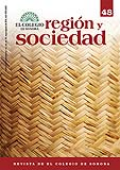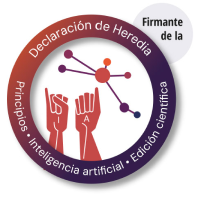 |
 |
 |
 |
 |
 |
 |
 |
 |
 |
 |
 |
Abstract
This article analyzes the behavior of per capita Gross Domestic Product among the twenty counties of the state of Nayarit between 1989-2004, within the framework of the effects of globalization. The information was organized in cross-section, according to three time periods. From the results obtained using a non-linear regression model, it is inferred that the divergence among the state's counties is becoming wider. The poorest counties were grouped in a club, and it was observed that they also show low levels of social well being.
References
Anselin, Luc. 1995. Local Indicators of Spatial Association–LISA. Geographical Analysis 27 (2): 93–115.
Aroca, Patricio y Mariano Bosch. 2000. Crecimiento, convergencia y espacio en las regiones chilenas: 1960–1998. Estudios de Economía 27 (2): 199–224.
Arroyo, Jesús y Édgar Olmos. 1998. Políticas económicas y distribución territorial de la población. En Economía regional y migración, coordinado por Jesús Arroyo. México: Universidad de Guadalajara, Asociación Mexicana de Población, Juan Pablos Editor.
Asuad, Normand y Luis Quintana. 2006. Convergencia espacial en el crecimiento económico de las entidades federativas de México, 1940–2004. Ponencia presentada en el XVI Coloquio mexicano de economía, matemática y econometría, Universidad Veracruzana.
Barceinas, Fernando y José Raymond. 2005. Convergencia regional y capital humano en México, de los años 80 al 2002. Estudios Económicos 20 (2): 263–293.
Boisier, Sergio. 1997. El vuelo de una cometa. Una metáfora para una teoría del desarrollo territorial. Ciclo de conferencias sobre conocimiento, globalización y territorio. Instituto Latinoamericano y del Caribe de Planificación Económica y Social, documento 97/37, Serie Ensayos.
Chapa, J. Benjamín. 2000. Desarrollo regional y política estructural en México. Espiral 6 (17): 211–221.
Delgado, Manuel. 2006. Economía, territorio y desigualdades regionales. Revista de Estudios Regionales 75 (1): 93–128.
Egner, Erich. 1967. Política regional y desarrollo económico. Estudios sobre la economía iberoamericana. Instituto de Investigación Económica de Gotinga. Barcelona: Ediciones Deusto.
Elbers, Chris, Jean Lanjouw y Peter Lanjouw. 2003. Micro–level Estimation of Poverty and Inequality. Econometrica. 71 (1): 355–364.
Esquivel, Gerardo. 1999. Convergencia regional en México, 1940–1995. El Trimestre Económico 66 (4): 725–761.
Garrido, Nicolás, Adriana Marina y Daniel Sotelsek. 2002. Convergencia económica en las provincias argentinas (1970–1995). Estudios de Economía Aplicada 20 (2): 403–421.
Gendarme, René. 1967. La pobreza de las naciones. Francia: Boletín Oficial del Estado.
Gerald, Curtis y Patrick Wheatley. 2001. Análisis numérico con aplicaciones. México: Editorial Alhambra Mexicana.
Germán–Soto, Vicente. 2005. Generación del producto interno bruto mexicano por entidad federativa, 1940–1992. El Trimestre Económico 72 (3): 617–653.
Gobierno del Estado de Nayarit. 2006. Plan Estatal de Desarrollo 2005–2011. Tepic. Formato digital.
––––––––––. 2000. Plan Estatal de Desarrollo 2000–2005. Tepic. Formato digital.
Gómez–Tagle, Erick. 2004. Ambientalismo, sustentabilidad urbana y desarrollo regional. Revista Mexicana de Ciencias Políticas y Sociales 46 (192): 113–140.
Gujarati, Damodar. 2005. Econometría. México: McGraw Hill.
INEGI. 2002. Síntesis de información geográfica del estado de Nayarit. México: INEGI.
––––––––––. 1989, 1994, 1999 y 2004. Censos económicos. Aguascalientes: INEGI.
––––––––––. 1980, 1990, 1995, 2000 y 2005. Censos y conteos generales de población. Aguascalientes: INEGI.
Isard, Walter. 1971. Métodos de análisis regional. Una introducción a la ciencia regional. Barcelona: Ediciones Ariel.
Jiménez, J. Alejandro. 2005. Las políticas de empleo en México y el desarrollo regional. Aportes 29 (2): 25–43.
Krugman, Paul y Maurice Obstfeld. 1996. Economía internacional. Teoría y política. Madrid: McGraw Hill.
Martínez, Juan. 2001. El crecimiento económico. http://www.eumed.net/cursecon/18/index.htm (3 de febrero de 2008).
Ortiz, Julián, Enrique Ortiz y Antonio Cárdenas. 2004. Revisión del debate sobre la pobreza, orientado al diseño de políticas. Análisis Económico 42 (19): 275–298.
Paredes, Jimmy y V. Vega. 1996. Econometría espacial aplicada al estudio de la migración en Chile. Tesis de ingeniería comercial, Universidad Católica del Norte.
Pindyck, Robert y Daniel Rubinfeld. 1998. Econometría: modelos y pronósticos. México: McGraw Hill.
Quah, Danny. 1996. Convergence Empirics across Economies with (some) Capital Mobility. Journal of Economic Growth 1: 95–124.
Richardson, Harry. 1973. Economía regional. Teoría de la localización, estructuras urbanas y crecimiento regional. Madrid: Editorial Vicens–Vives.
Rionda, Jorge. 2006. Desequilibrios estructurales y desarrollo en México. http://www.eumed.net/cursecon/ecolat/mx/2006jirr–0606.htm (3 de febrero de 2008).
Russo, José y Felisa Ceña. 2000. Evolución de la convergencia y disparidades provinciales en Argentina. Revista de Estudios Regionales 57: 151–173.
SCT. 1994. Mapa carretero de México. México.
Timmer, Peter. 1995. Getting Agriculture Moving: do Markets Provide the Right Signals? Food Policy 20 (5): 455–472.
Vargas, José. 2006. Desarrollo multinivel: implicaciones macro–regional, local y micro–regional. Urbano 9 (14): 56–68.
Villaverde, José y Blanca Sánchez. 1998. Disparidades provinciales y clubes de convergencia en España. Estudios Regionales 2: 177–199.
Williamson, Jeffrey. 1975. Regional Inequality and the Process of National Development: A Description of the Patterns. Economic Development and Cultural Change 13 (4): 158–200.
Open access policy
The authors who publish in región y sociedad accept the following conditions:
In accordance with the copyright laws, región y sociedad recognizes and respects the authors’ moral rights, as well as the ownership of property rights, which will be transferred to the journal to disseminate the articles in open access. región y sociedad does not charge the authors for submitting and processing articles for publication.
All the texts published by región y sociedad —with no exception— are distributed under a Creative Commons license 4.0 Attribution – Noncommercial (CC BY-NC 4.0 International), which allows third parties to use the publication as long as they mention the works’ authorship and the first publication in this journal.
The authors can enter into independent and additional contractual agreements for the nonexclusive distribution of the version of the article published in región y sociedad (for instance include it into an institutional repository or publish it in a book) as long as they clearly indicate that the work was published for the first time in región y sociedad.
For all the above, the author(s) must send the Letter of transfer of property rights of the first publication duly filled in and signed by the author(s). This letter can be sent by e-mail as a PDF to: region@colson.edu.mx






